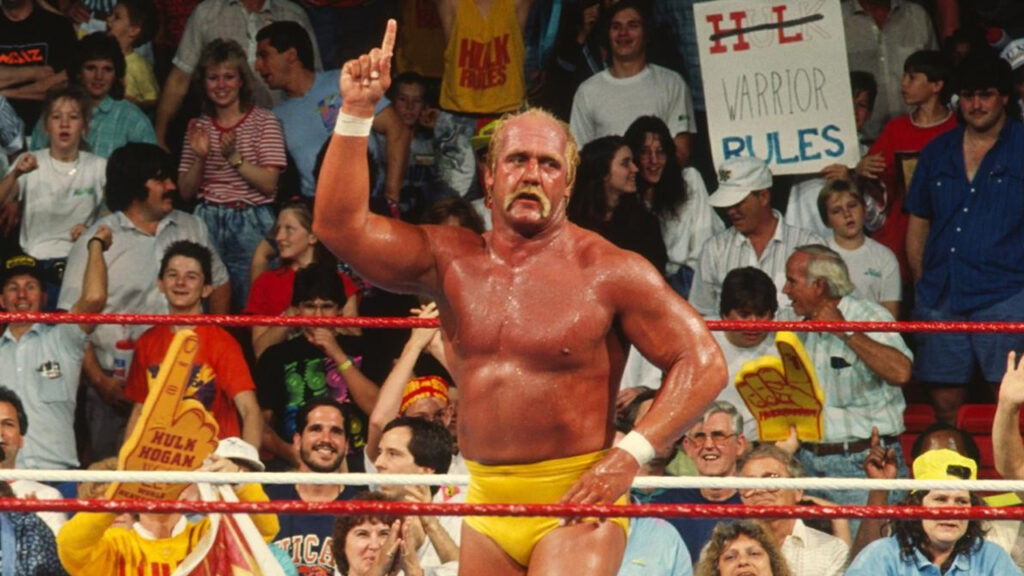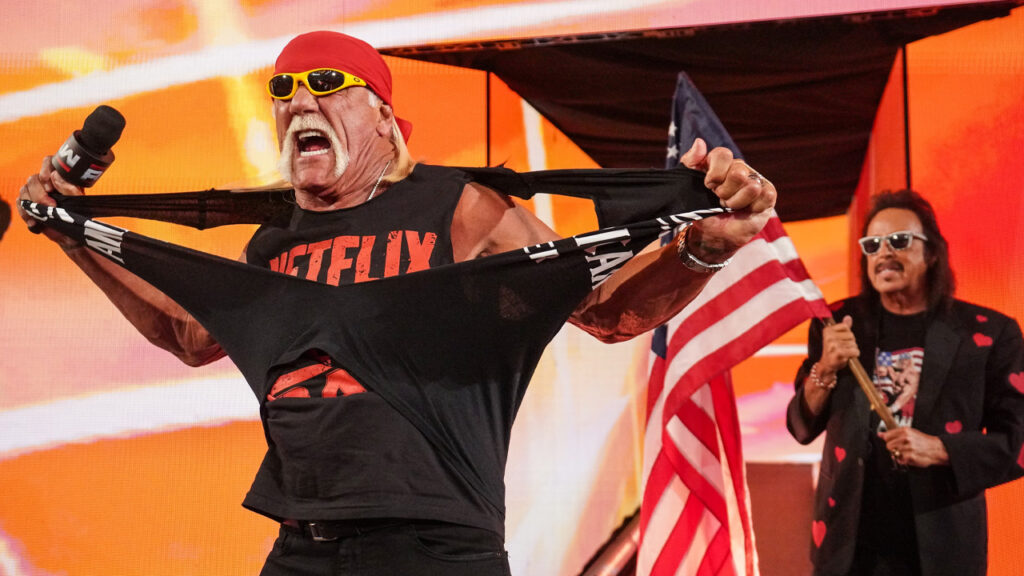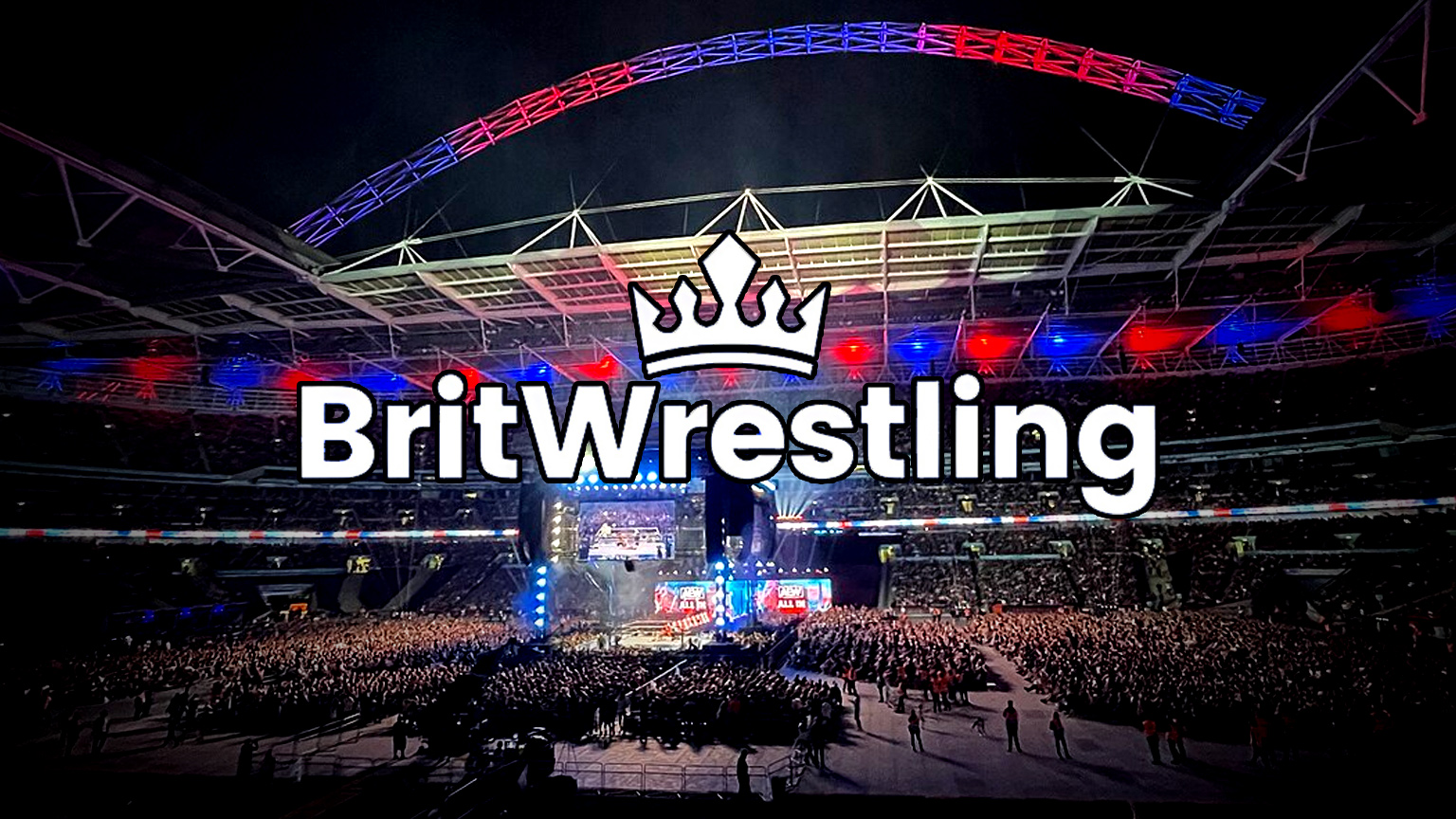We all know Hulk Hogan lies about almost everything in his life, but his fibs about wrestling at Wembley Stadium really do take the piss.
The two-time WWE Hall of Famer and notorious racist lied about wrestling at Wembley Stadium, inventing the tragedy of a dying child to try and sell his dreadful rock ‘n’ roll album.
His 1995 “Hulk Rules” album stormed to the bottom of the charts during his stint in WCW. The songs had allegedly been written by himself and Jimmy Hart, featuring such hits as “Beach Patrol”, “Hulk’s Back!” and the horrendous “Hulkster In Heaven”.
It is the last one that we will be talking about today. Hogan lied about wrestling in Wembley Stadium in front of 80,000 fans, lamenting the smelly death (Hogan’s words) of the fan just moments earlier.
In his mind, this worked, as Hogan also lied about the album being a big hit, despite it being less notorious than the infamous Randy Savage rap album (“Be A Man“) some years later.
Hogan claimed that he wrestled at Wembley Stadium at Summerslam 1992, but a dying child he promised front-row seats never showed up. Later learning that he died, he spent the night writing an album in his honour, which included the iconic “Hulkster in Heaven” song created, allegedly, in tribute to the child.
However, would it shock you to hear that almost everything Hulk Hogan said about this song was a complete and utter lie? And I don’t mean the story was just made up. Nearly every single fact within the tale was also absolute rubbish.
Hulk Hogan, Wembley Stadium And A Dying Child

Our story begins at Wembley Stadium in London, England. Hulk Hogan is about to wrestle at the historic football venue in the UK’s biggest wrestling show of all time.
Hulk Hogan’s song “Hulkster in Heaven” was written about a Make-A-Wish child that he met, but later passed away. Hogan has previously claimed that he met the child prior to Summerslam 1992, but only learned that he died when he looked out into the crowd and saw an empty seat at ringside, where the child was supposed to be sat.
However, he claimed in an interview with Muscle and Fitness that he smelled the child dying backstage, just moments before he walked out to wrestle at the event.
After the event, he wrote an entire album called “Hulk Rules”, allegedly paying tribute to the child. This included the emotional ballad “Hulkster in Heaven”, where Hogan half-sang about the young child dying at Wembley Stadium before seeing Hogan wrestling at Summerslam 1992.
The song is written from Hulk Hogans’s perspective and features some incredible lyrics such as”First I tore my shirt, but now you’ve torn my heart”.
The song sees Hogan speak out about peering into the crowd in Wembley Stadium, seeing an empty seat where the child should have been sat. (“There’ll be an empty seat, when I wrestle at Wembley”).
His backup singers belt out “You were my friend!” numerous times, the past tense making it clear that the child had since perished. Despite being surrounded by over 70,000 screaming wrestling fans, Hulk Hogan had never felt so alone, brother.
It truly was a tragic basis for a tune. The devastation of losing such a brave child, battling for their life only to lose the fight just before seeing their hero fight in London must have been a traumatic experience for Hogan. Maybe he used the song to deal with his own trauma, as many great songwriters in history have?
However, there is one slight issue with that story – Hulk Hogan never, ever wrestled at Wembley Stadium.
Hulk Hogan Lied About Wrestling At Wembley Stadium
We knew Hulk Hogan was an abhorrent individual with zero morals and a disregard for anybody but himself (and Brutus Beefcake, for some reason) so the invention of a dying child should not come as a shock.
However, coming up with such easily provable lies is just moronic. The only time Hulk Hogan could have wrestled at Wembley Stadium was at Summerslam 1992. That was the only time either WWE or WCW ran the stadium either during, before or after Hogan’s wrestling career.
The WWE brought SummerSlam 1992 to the United Kingdom during a challenging period in its history. While business in the United States was struggling, Bret Hart and The British Bulldog had become major draws in the UK, leading to heightened popularity for the company in the region.
Vince McMahon made the bold decision to book the 80,000-seater Wembley Stadium—a venue later demolished and rebuilt, with AEW famously hosting an event there in 2023.
SummerSlam 1992 featured a memorable main event with Bret Hart defending the Intercontinental Championship against The British Bulldog. The card also included The Ultimate Warrior challenging “Macho Man” Randy Savage for the WWE Championship. Stars like The Undertaker and Shawn Michaels were in action as well.
Did you know: Vince McMahon called Bret Hart vs British Bulldog the best match he’d ever seen!
But one name was conspicuously absent: Hulk Hogan.
Hogan wasn’t at Wembley Stadium. In fact, he wasn’t even in the UK. By that time, Hogan was on a long hiatus following WrestleMania VIII, partly due to the fallout from the steroid trial that had put WWE under intense scrutiny. He was never booked for the event. Hogan didn’t wrestle at Wembley that night—and, notably, he has never wrestled at Wembley Stadium.
Despite this, Hogan later claimed to have wrestled at Wembley Stadium, a claim tied to the promotion of a music album. The assertion was a blatant fabrication and stands as one of the most shameless promotional tactics in wrestling history—a significant feat given the industry’s history.
To clarify, Hogan did wrestle in the UK in September 1994 during WCW’s Hulkamania tour. He faced Ric Flair at Wembley Arena, not the larger Wembley Stadium. This occurred a year before the album’s release and could suggest Hogan simply confused the two venues.
So, you could give him the benefit of the doubt. Over the years it would be easy to mix up Wembley Stadium and Wembley Arena and a more trustworthy man would be given the benefit of the doubt on the matter.
However, Hogan’s ongoing embellishments and outright falsehoods regarding the event make it clear this wasn’t a simple mistake—it was an intentional rewrite of history.
Hulk Hogan Has Lied A Lot More About Summerslam 1992

If you wanted to give Hulk Hogan the benefit of the doubt about his claim of wrestling at Wembley Stadium in London, then maybe this will take away any doubt that he is a born liar.
During an interview with Muscle & Fitness Magazine in 2023, Hulk Hogan spun a bizarre and utterly fabricated tale about being at Wembley Stadium with Michael Jackson and Mr. T. In one of his most outlandish claims yet, Hogan recounted (brace yourself for this) that he “smelled a Make-A-Wish child dying.”
Hogan’s ever-changing story about writing the song “Hulkster in Heaven” reached new levels of absurdity in this latest iteration. He claimed that he booked a ringside seat for a terminally ill child at SummerSlam 1992. According to Hogan, he wrestled in the main event of the show and kept looking for the child during the match.
When the boy wasn’t there, Hogan said he went backstage and learned from the child’s parents that he had tragically passed away. Inspired by this loss, Hogan claimed he and his manager, Jimmy Hart, locked themselves in a hotel room and wrote 12 songs overnight as a tribute to the young fan.
The alleged album, filled with “inspirational and melancholy” tracks like “Hulkster’s in the House,” “Wrestling Boot Traveling Band,” “Beach Patrol,” and “Hulkster in Heaven,” was supposedly produced with the help of Simon Cowell. Hogan even stated that the album went to #1 on the Billboard charts for eight weeks and that proceeds were donated to the family—a claim that is completely false.
Hogan went further, saying he introduced Simon Cowell to the United States and got him involved in producing music for The Wrestling Album and its follow-up, Piledriver. He also claimed to have orchestrated the production of “Land of 1000 Dances” and helped Cowell work with a UK band on a Gary Glitter cover, all of which supposedly propelled Cowell to fame.
To recap the reality:
- Hulk Hogan wasn’t at SummerSlam 1992 at Wembley Stadium. He was on hiatus at the time and has never wrestled at Wembley Stadium.
- Michael Jackson and Mr. T weren’t at SummerSlam 1992.
- “Hulkster in Heaven” was part of the 1995 Hulk Rules album, released during Hogan’s WCW run—three years after SummerSlam 1992.
- The album never hit #1 on the Billboard charts; it charted modestly on the Kids’ Album Chart.
- Simon Cowell didn’t produce any of Hogan’s albums. He did produce WrestleMania: The Album in 1993 for WWF, which had no involvement from Hogan since he was in WCW by that time.
- The Gary Glitter cover Hogan referenced charted in the UK in 1993 but had nothing to do with Billboard or Hogan.
- The timeline Hogan presented, connecting all of this to the Rock ‘n’ Wrestling era, is wildly inaccurate, as Rock ‘n’ Wrestling occurred in 1985.
In classic Hogan fashion, he took a few tiny grains of truth (that he’s a wrestler, made an album, and Wembley Stadium exists) and spun them into an elaborate web of lies. His story about “Hulkster in Heaven” is a tangled mess of self-aggrandizement, factual inaccuracies, and shameless embellishment.
At this point, Hulk Hogan’s tall tales are almost as legendary as his wrestling career—but not in a good way.
During a recent interview with Muscle & Fitness Magazine, Hulk Hogan spun a bizarre and utterly fabricated tale about being at Wembley Stadium with Michael Jackson and Mr. T. In one of his most outlandish claims yet, Hogan recounted (brace yourself for this) that he “smelled a Make-A-Wish child dying.”
Hogan’s ever-changing story about writing the song “Hulkster in Heaven” reached new levels of absurdity in this latest iteration. He claimed that he booked a ringside seat for a terminally ill child at SummerSlam 1992. According to Hogan, he wrestled in the main event of the show and kept looking for the child during the match.
When the boy wasn’t there, Hogan said he went backstage and learned from the child’s parents that he had tragically passed away. Inspired by this loss, Hogan claimed he and his manager, Jimmy Hart, locked themselves in a hotel room and wrote 12 songs overnight as a tribute to the young fan.
The alleged album, filled with “inspirational and melancholy” tracks like “Hulkster’s in the House,” “Wrestling Boot Traveling Band,” “Beach Patrol,” and “Hulkster in Heaven,” was supposedly produced with the help of Simon Cowell.
Hogan even stated that the album went to #1 on the Billboard charts for eight weeks and that proceeds were donated to the family—a claim that is completely false.
Hogan went further, saying he introduced Simon Cowell to the United States and got him involved in producing music for The Wrestling Album and its follow-up, Piledriver.
He also claimed to have orchestrated the production of “Land of 1000 Dances” and helped Cowell work with a UK band on a Gary Glitter cover, all of which supposedly propelled Cowell to fame.
To recap the reality:
- Hulk Hogan wasn’t at SummerSlam 1992 at Wembley Stadium. He was on hiatus at the time and has never wrestled at Wembley Stadium.
- Michael Jackson and Mr. T weren’t at SummerSlam 1992.
- “Hulkster in Heaven” was part of the 1995 Hulk Rules album, released during Hogan’s WCW run—three years after SummerSlam 1992.
- The album never hit #1 on the Billboard charts; it charted modestly on the Kids’ Album Chart.
- Simon Cowell didn’t produce any of Hogan’s albums. He did produce WrestleMania: The Album in 1993 for WWF, which had no involvement from Hogan since he was in WCW by that time.
- The Gary Glitter cover Hogan referenced charted in the UK in 1993 but had nothing to do with Billboard or Hogan.
- The timeline Hogan presented, connecting all of this to the Rock ‘n’ Wrestling era, is wildly inaccurate, as Rock ‘n’ Wrestling occurred in 1985.
In classic Hogan fashion, he took a few tiny grains of truth (that he’s a wrestler, made an album, and Wembley Stadium exists) and spun them into an elaborate web of lies.
His story about “Hulkster in Heaven” is a tangled mess of self-aggrandizement, factual inaccuracies, and shameless embellishment.
At this point, Hulk Hogan’s tall tales are almost as legendary as his wrestling career—but not in a good way.

